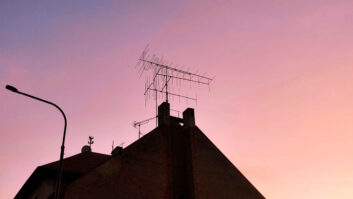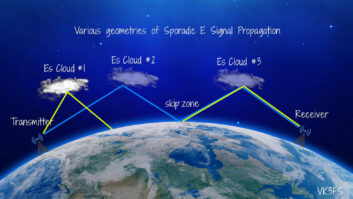David Houze is Ecreso product manager, leading development of the FM transmitter range in collaboration with WorldCast Systems’ R&D team. He is also an application engineer supporting WorldCast’s APT, Audemat, Ecreso and Kybio brands. He spoke with us for the Radio World ebook “Transmission 2024.”
Radio World: You’ve commented that although FM broadcasting has been well-established for many years, there are still important advancements in transmitter technology.
David Houze: One of the most significant trends is the focus on energy efficiency and sustainability.

In our daily lives, we are all concerned about electricity, firstly due to the rising prices, but also thanks to ecological awareness and the huge impact of electricity generation.
It is imperative that each individual FM manufacturer address these issues, especially in the context of equipment operating around the clock with substantial electricity demands.
While it was through intensive research on hardware improvements to reduce the consumption, for example with notable improvements on the MOSFET and power supply, FM manufacturers and broadcasters are now looking at additional improvements based on software technologies to reduce electricity demands, such as embedding software modules to replace hardware devices, or integrating an algorithm to optimize the consumption of the transmitter based on the listening audience as well as the audio content.
RW: What key questions should transmitter buyers consider?
Houze: There’s more to the decision than meets the eye. While factors like required output power and efficiency are evident, there are nuanced considerations that can significantly impact your broadcasting setup.
Manufacturers often highlight peak efficiency, yet the true cost of operating the transmitter over 5 to 10 years remains undisclosed. Vital questions arise: What are the operating costs, the expected lifespan and the necessary maintenance throughout the product’s life?
Another pivotal choice revolves around the modulator type. While analog modulators are cost-effective, the unrivaled audio fidelity and the potential for advanced features like spectrum analysis and sound processing make digital modulators an appealing prospect.
Failure management is crucial. What’s the strategy in the event of transmitter failure? Is there a capability to repair the equipment promptly, or is the plan to maintain minimum operation levels during downtimes?
Moreover, in today’s digital landscape, the ability for remote control and monitoring is paramount. How efficiently can the system be managed and troubleshot from a distance?
Last, it’s essential to consider future needs. Do you anticipate the requirement for upgrades and infrastructure changes? Assessing whether the transmitter can adapt to these changes through hardware or software modifications is vital for long-term planning.
Selecting an FM transmitter demands a holistic approach, delving into not only the immediate specifications but also the long-term cost-effectiveness, adaptability, and resilience in various scenarios.
RW: What technical features are important to look for?
Houze: Two noteworthy features deserve attention. The first, SmartFM, helps broadcasters to improve their op-ex. Available in WorldCast transmitters today, and soon in transmitters from other manufacturers, this technology analyzes the audio content in real time and dynamically adjusts the output power to maintain the audio listening quality while reducing the electricity demand. So far, SmartFM stands as the only known solution to breach the physical limit of efficiency resulting in a substantial reduction in electricity consumption by up to 40%.
The second feature is the MPX transport over IP. This is a complete game-changer for radios as it drastically drops down the initial deployment costs.
The principle is quite simple: Instead of transporting separately the audio and the RDS data from the “studio” to the transmitter site, only the MPX is sent to the transmitter site. The signal is processed only once, at the studio, instead of processing it at all sites on reception. Broadcasters drastically reduce the number of sound processors, stereo encoders and RDS encoders at their sites.
RW: How will transmitter design change in the next five years?
Houze: At the moment, users must choose between compact systems and modular systems. In coming years, more and more transmitters will be released with a compact and modular design. Operators will benefit from the best of compact transmitters — the footprint and ease of installation — with the ease of repair that comes with modularity.
This change has already started for premium manufacturers at medium power, but it will become a priority for higher power as well.
The second main change concerns environmental awareness and the need to reduce electronic components; this will drastically change the philosophy of transmitter design. Manufacturers will progressively replace one-feature boards like the stereo encoder, RDS encoder and sound processor with activable options on key hardware modules such as the modulator.
This results in a more environmentally-friendly electronic approach for manufacturers and a more profitable solution for users, who can upgrade their transmitter with new features through software, without hardware operation.
RW: How can an engineer protect a transmitter and its related infrastructure from cyber attacks?
Houze: Customers often ask what they can do to protect their investment. It’s a matter of how many walls you build between the intruder and your network, and whether it’s worth spending time to break them.
The first thing is to block all communications on the company firewall; then the engineers should only allow mandatory communication such as web access. preferring secured protocols such as HTTPS. The second to check is password security. It is mandatory to change the default password before connecting the equipment to the internet.
Then activate the security features of your transmitters. In the AiO series, we have embedded a firewall to block all unattended communications because we know that some users cannot afford to purchase a “high quality” firewall or do not have the knowledge to administer it.
And finally, the best advice I can offer is to make regular penetration tests with security experts. We do it on a regular basis for our equipment to ensure the best level of security. It is always useful to discover new threats that can be fixed in a few hours of work to protect your network!
RW: How can managers best calculate the cost to operate over time?
Houze: Usually, managers calculate operating costs based on the transmitter efficiency only. They then can calculate the yearly consumption and estimate the electricity costs over time. At this stage, it is also important to take into account the price inflation that may arise. In our estimation, it is around 4% per year.
But there are additional criteria regarding product maintenance. Preventive maintenance involves replacing some components after a few years, for example the fan and main power supply. Manufacturers generally give guidelines to replace these modules. And managers should take into account the cost of repairs. It can be based on previous experience with transmitters, however it differs from one brand to another.
In my opinion, the best way to estimate the cost of repairs is to check the warranty details. Usually, the longer the standard warranty, the more reliable the product.
Managers also can ask the price for a warranty extension to 5 or 10 years; this provides a fixed annual cost for maintenance.







